

The World's Biomes. WorldBiomes.com - Explore Five of the World's Main Biomes. WorldBiomes.com - Explore Five of the World's Main Biomes. Biomes. A biome is a large, distinctive complex of plant communities created and maintained by climate.
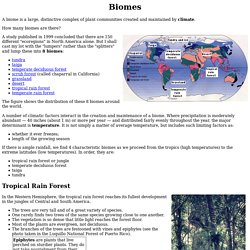
How many biomes are there? A study published in 1999 concluded that there are 150 different "ecoregions" in North America alone. But I shall cast my lot with the "lumpers" rather than the "splitters" and lump these into 8 biomes: The figure shows the distribution of these 8 biomes around the world. A number of climatic factors interact in the creation and maintenance of a biome.
Where precipitation is moderately abundant — 40 inches (about 1 m) or more per year — and distributed fairly evenly throughout the year, the major determinant is temperature. Whether it ever freezes; length of the growing season If there is ample rainfall, we find 4 characteristic biomes as we proceed from the tropics (high temperatures) to the extreme latitudes (low temperatures). Tropical Rain Forest The tropical rain forest exceeds all the other biomes in the diversity of its animals as well as plants.
Taiga Tundra. Mission: Biomes. Blue Planet Biomes - World Biomes. What is a Biome?
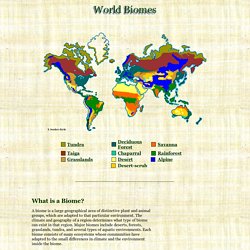
A biome is a large geographical area of distinctive plant and animal groups, which are adapted to that particular environment. The climate and geography of a region determines what type of biome can exist in that region. Major biomes include deserts, forests, grasslands, tundra, and several types of aquatic environments. Each biome consists of many ecosystems whose communities have adapted to the small differences in climate and the environment inside the biome.
All living things are closely related to their environment. The earth includes a huge variety of living things, from complex plants and animals to very simple, one-celled organisms. Biome. Different biomes Ecoregions are grouped into both biomes and ecozones.
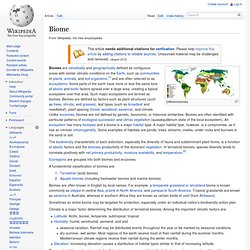
A fundamental classification of biomes are: Terrestrial (land) biomesAquatic biomes (including freshwater biomes and marine biomes) Biomes are often known in English by local names. For example, a temperate grassland or shrubland biome is known commonly as steppe in central Asia, prairie in North America, and pampas in South America. Sometimes an entire biome may be targeted for protection, especially under an individual nation's biodiversity action plan. Climate is a major factor determining the distribution of terrestrial biomes. The most widely used systems of classifying biomes correspond to latitude (or temperature zoning) and humidity. Biomes Biomes of the World
Biome - humans, examples, body, water, process, Earth, life, plants, type, characteristics, form, animals, system, parts, plant, waves, surface, part. Photo by: Thomas Pozzo di Borgo A biome is an ecosystem containing plant and animal species that are characteristic to a specific geographic region.
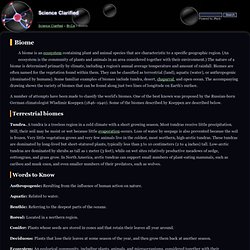
(An ecosystem is the community of plants and animals in an area considered together with their environment.) The nature of a biome is determined primarily by climate, including a region's annual average temperature and amount of rainfall. Biomes are often named for the vegetation found within them. They can be classified as terrestrial (land), aquatic (water), or anthropogenic (dominated by humans). A number of attempts have been made to classify the world's biomes. Biome - Palaeos.org. From Palaeos.org The biome is a major terrestrial assemblage of plants, animals, and microorganisms that has a characteristic appearance and occurs over large geographical areas on the earth's surface.
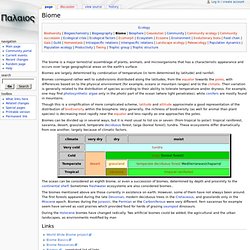
Biomes are largely determined by combination of temperature (in term determined by latitude) and rainfall. Biomes correspond rather well to subdivisions distributed along the latitudes, from the equator towards the poles, with differences based on to the physical environment (for example, oceans or mountain ranges) and to the climate. Their variation is generally related to the distribution of species according to their ability to tolerate temperature and/or dryness.
For example, one may find photosynthetic algae only in the photic part of the ocean (where light penetrates), while conifers are mostly found in mountains. Biomes. Biomes, Ecosystems & Habitats. Biomes and Ecozones. For ease of study, topics have been divided into 11 categories.

Map of World Biomes. Biomes of the World. Ecosystems of Our World. Major Biomes of the World. Have you visited any biomes lately?

A biome is a large ecosystem where plants, animals, insects, and people live in a certain type of climate. If you were in northern Alaska, you would be in a frosty biome called the Arctic tundra. If you jumped on a plane and flew to Brazil, you could be in a hot and humid biome called the tropical rainforest. Biomes of the World - Biome Map. Click on a biome on the above graph for more information, informative videos, and links to scientist profiles, travel information, lesson plans and species profiles for each region.
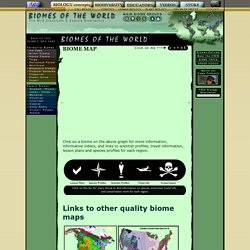
We'd like to know where you're coming from. If you've used this site for a class project or browsing for fun, add yourself to our map and communicate with other "ecogeeks"